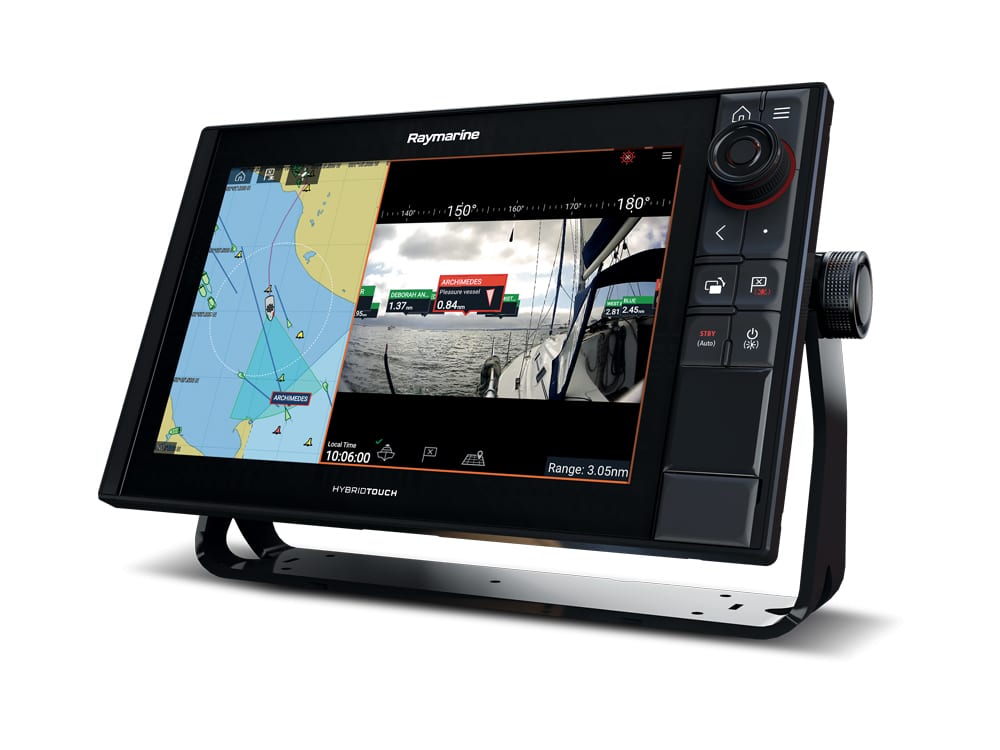
Florida’s early morning sunshine flooded the sky as we motored out of Pompano Beach, our Boston Whaler 380 Outrage aimed at Hillsboro Inlet. The waters were flat, but the rising sun in our eyes complicated watchkeeping.
Fortunately, one of the boat’s Raymarine Axiom XL multifunction displays was running ClearCruise AR, an augmented-reality system that graphically overlays tags atop navigational information to create a real-time video feed. Despite the sun’s glaring angle, we could easily spot buoys and channel markers on the video feed and — if we tapped on a tag — on the chart plotter screen too.
While there’s no substitute for sharp eyes, ClearCruise AR offers new levels of situational awareness and collision avoidance. The system consists of a Raymarine Axiom, Axiom Pro or Axiom XL multifunction display ($849 to $12,299) that’s running Raymarine’s Lighthouse 3.7 (or newer) operating system; a Raymarine AR200 IP Camera Stabilization Module ($499); and as many as 10 Raymarine fixed-mount CAM210IP ($699) or CAM220IP ($499) high-definition marine cameras.
The MFD shows a video feed from the cameras, as well as AIS data, a graphical azimuth banner ring and compatible vector cartography (currently Navionics and Raymarine’s Lighthouse, with C-Map compatibility expected soon). There’s complex math involved, but the components create a user-friendly video feed of the real-world horizon “augmented” with information-rich AR tags above, say, aids to navigation and AIS-equipped vessels.
ClearCruise AR knows the camera’s field of view and where its lens is pointing. The system can pull corresponding information from the vector cartography’s supporting database and the nav system’s AIS and GPS data. The AR200 module has a built-in GNSS receiver and a solid-state, nine-axis attitude heading reference system that constantly corrects for the vessel’s heading, pitch, roll and yaw.
Let’s say a commercial ship enters a camera’s frame. ClearCruise AR graphically overlays a color-coded AR tag, based on the target’s threat level. Nonthreatening AIS targets are labeled with green AR tags, while red-tagged targets require attention. ClearCruise AR also differentiates targets based on proximity and displays nearby target tags higher off the horizon.
ClearCruise AR tags also denote the vessel or object’s name and distance, and an icon indicates direction of travel. Users can tap an AR tag to learn next-level information such as an AIS-equipped vessel’s course and speed over ground, its closest point of approach and more.
In the case of a man overboard, a user taps the display’s MOB button and the system generates a blue AR tag, helping the crew navigate back to the MOB’s last known position. Alternatively, if the MOB activates an AIS-enabled beacon, ClearCruise AR can get the position information from the yacht’s networked AIS.

“ClearCruise AR brings that clear awareness of what’s ahead of you, and it gives you a visual confirmation that you are where you think you are,” says Jim McGowan, Raymarine’s Americas marketing manager. “The flags fall right over the buoys. It’s the same with AIS — it’s easy to lose track of who is coming and going, but with ClearCruise AR, it’s instant recognition.”
In situations where non-AIS-equipped vessels appear in the video feed, the system presents video imagery sans AR tags. “It’s like looking at it with the naked eye,” McGowan says. “You see what you see. There’s no additional context.”
As impressive as ClearCruise AR’s capabilities are, it’s equally important to know the system’s current limitations. McGowan says it can be challenging for users to determine what’s unfurling on screen if the yacht is in a narrow channel with multiple oncoming vessels in a row, but only one that is AIS-equipped. On the flip side, however, if all four vessels are AIS-equipped, the system prioritizes and stacks its AR tags like cards.
Dense fog also presents a challenge, because the cameras register walls of gray. For the best system performance, McGowan recommends running in split-screen mode with the ClearCruise AR video feed on the MFD’s right-hand side and a chart-plotter screen with overlaid AIS data on the left.
“ClearCruise AR is best suited to big-screen displays,” he says, citing the amount of data and imagery that’s being displayed on screen and the ease of tapping targets in lumpy seaways (remote keypads are available for Axiom MFDs).
Of paramount importance is that this technology, much like a Tesla’s auto-driving capabilities, by no means absolves skippers of their watchkeeping responsibilities. Nor will the technology engage the vessel’s autopilot or engine to prevent a collision.
Fortunately, unlike with a chart plotter or radar screen, ClearCruise AR uses real-world video imagery. “I know there’s a tendency to go heads-down with navigation, but the base view is the same as looking out the window,” McGowan says. “You always need to keep your head on a swivel, but I think AR will help.”
While ClearCruise AR isn’t a navigational panacea, it is poised to help mariners better negotiate hectic or unfamiliar waters, and visually confirm their navigation. AR is a tool, not a co-pilot, as we all welcome the coming wave of marine-focused artificial intelligence.









